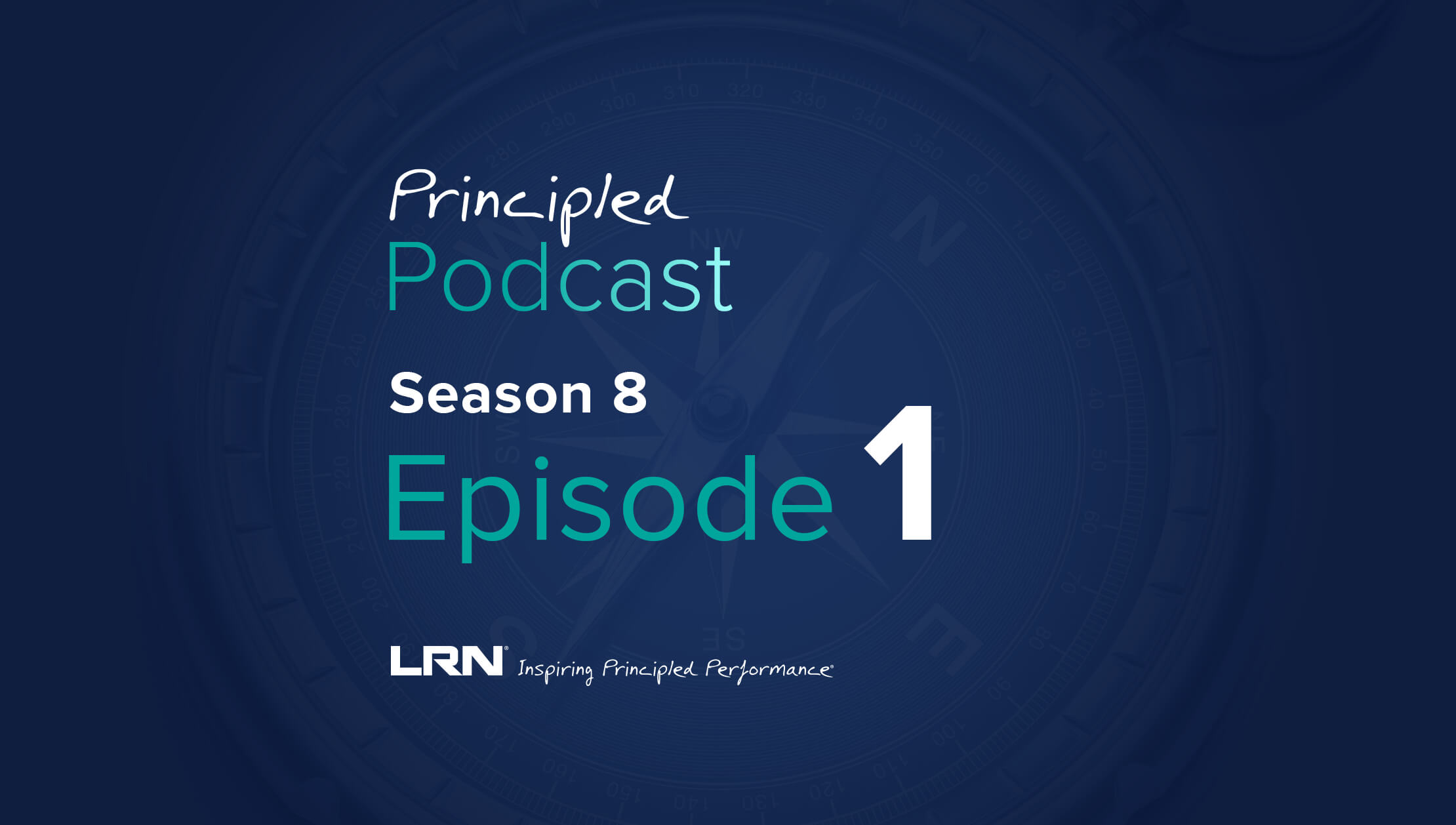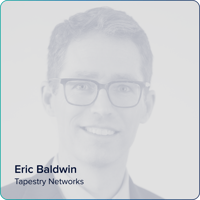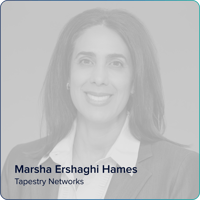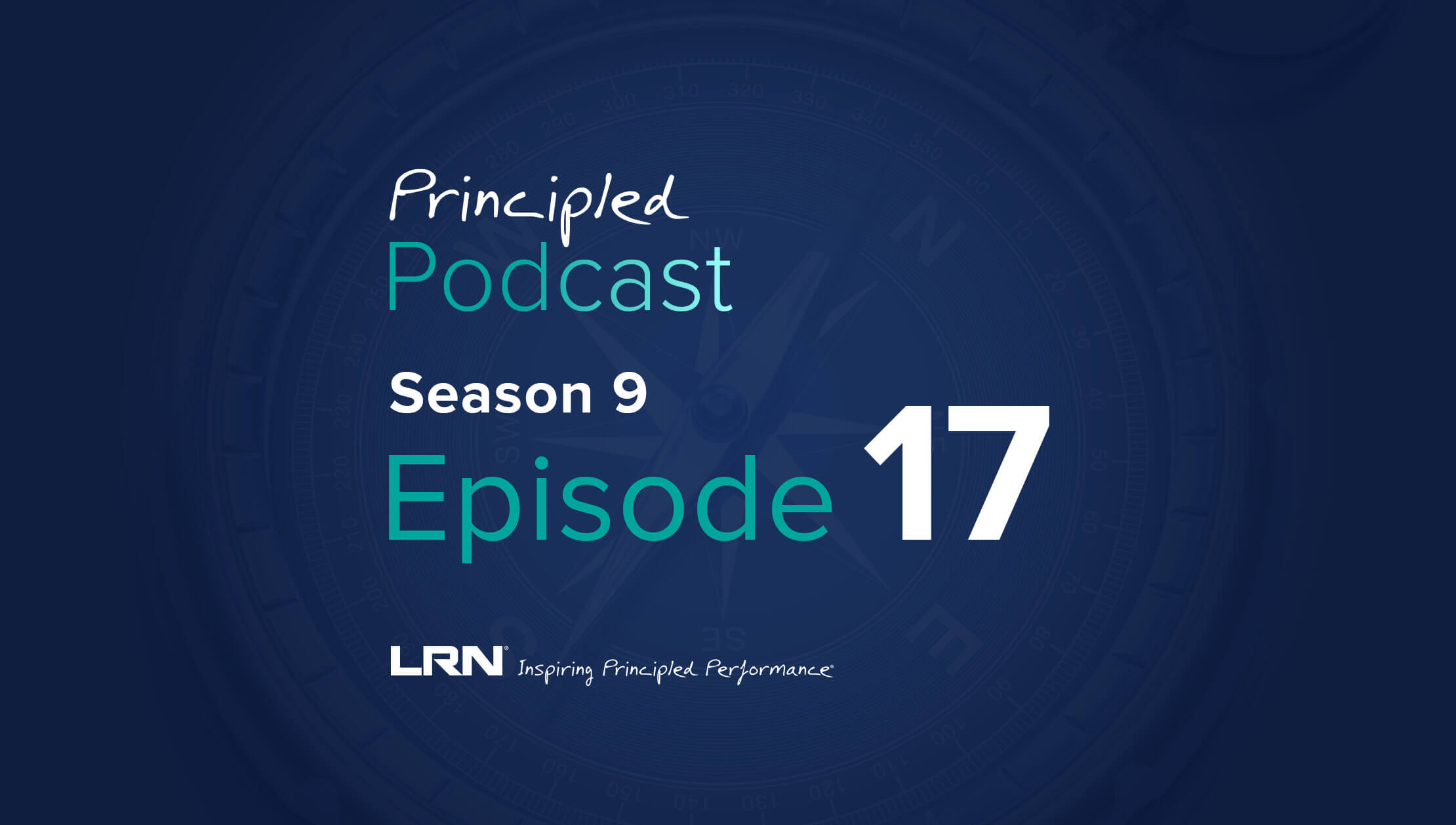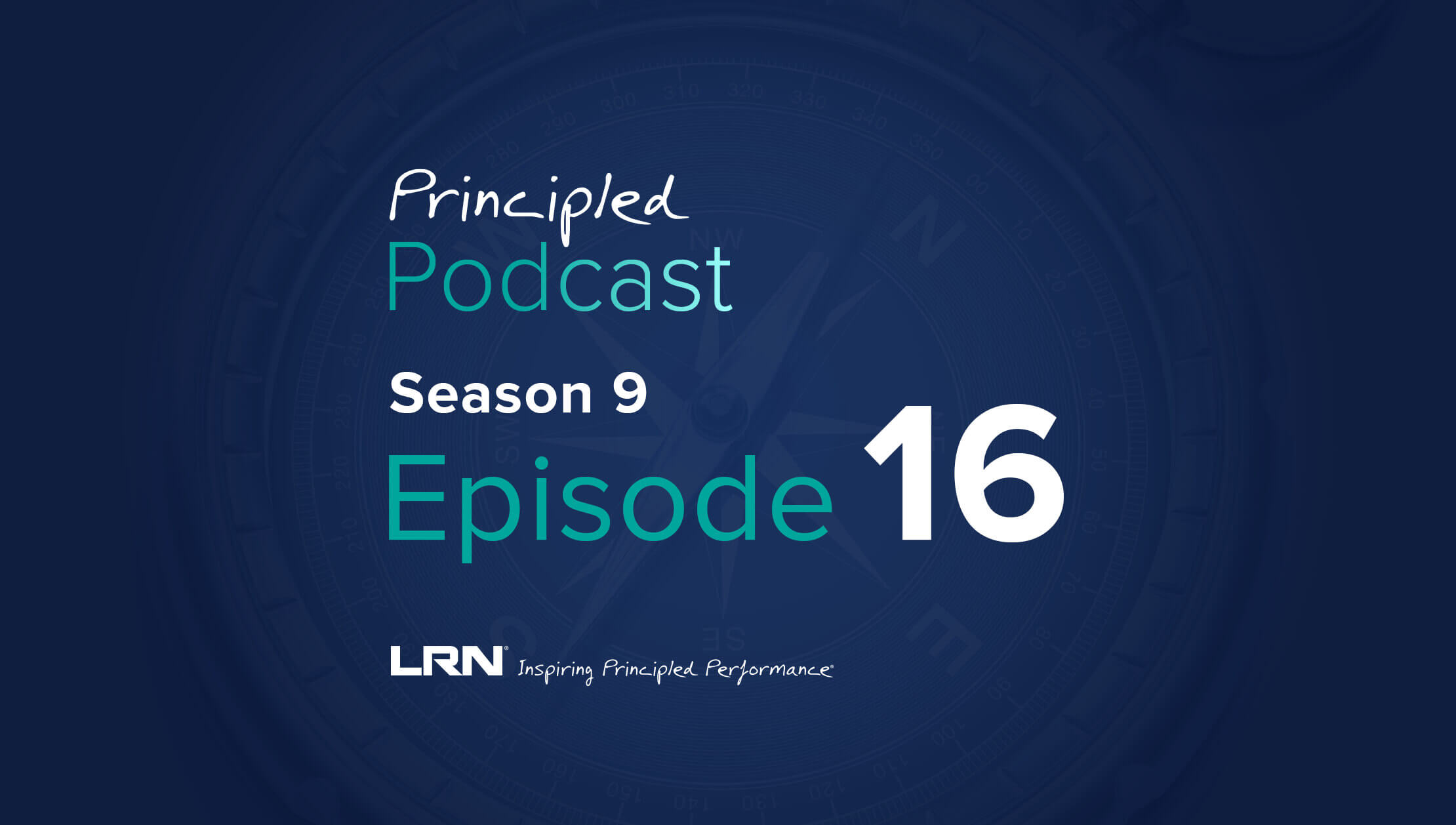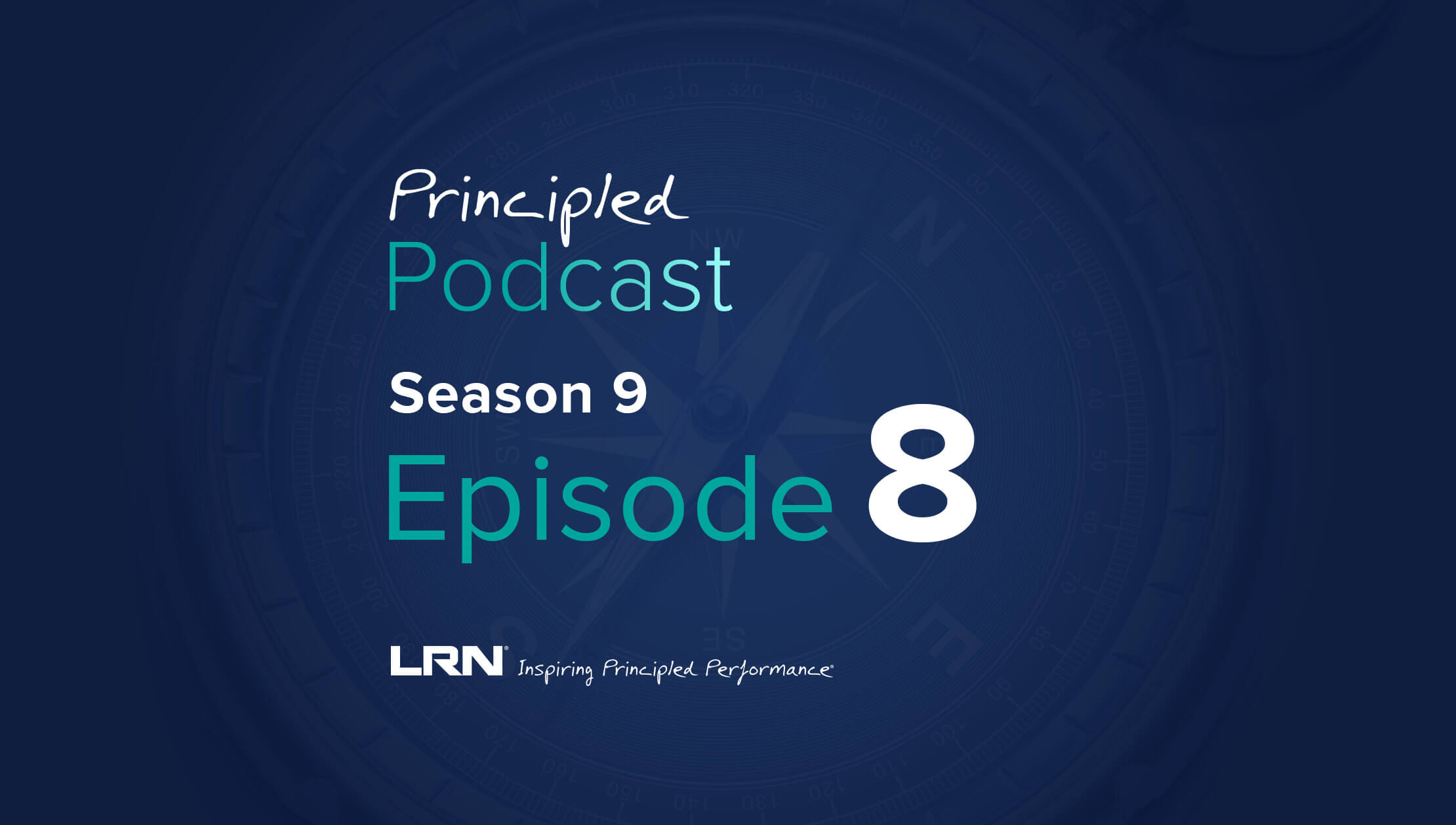What you'll learn on this podcast episode
What is top of mind with board directors when they think about corporate culture, ethics, and compliance? How can leaders best assess culture in the companies they oversee? In the season 8 premiere of the Principled Podcast, LRN Director of Advisory Services Emily Miner is joined by Dr. Marsha Ershaghi Hames and Dr. Eric Baldwin at Tapestry Networks to discuss how board members can improve oversight. Listen in as the group shares insights from Tapestry Networks and LRN’s joint report Assessing Corporate Culture: A Practical Guide to Improving Board Oversight, which draws from a working group of nearly 40 directors and executives representing over 60 public companies.
Principled Podcast Show Notes
- [0:29] - Emily welcomes listeners to this episode with Marsha and Eric of Tapestry Networks.
- [1:46] - A discussion on the recently published report, “Assessing Corporate Culture: A Practical Guide to Improving Board Oversight.”
- [6:14] - Why the report offers a practical framework and what needs it seeks to address.
- [9:59] - The key findings or pillars of the report.
- [15:22] - How the report helps leaders answer “How?” questions.
- [20:30] - What is the potential broader impact of the report?
Where to stream
Be sure to subscribe to the Principled Podcast wherever you get your podcasts.
Guest: Dr. Eric Baldwin
Eric Baldwin is a principal at Tapestry Networks, working with teams in the firm’s corporate governance and financial services practices. Prior to coming to Tapestry, he served for several years as a research associate at Harvard Business School (HBS), where he collaborated with faculty on a variety of research and writing projects covering topics ranging from organizational culture and change management to corporate strategy and healthcare policy. Prior to his time at HBS, Eric taught in the religious studies departments at Franklin & Marshall College and Boston University, while earlier in his career he served in engineering and operations roles at ON Technology Corporation, a software development firm based in greater Boston.
Eric holds a PhD in religious studies from Boston University and a BA in history from the College of William and Mary.
Guest: Dr. Marsha Ershaghi Hames
Dr. Marsha Ershaghi Hames is a partner with Tapestry Networks and a leader of our corporate governance practice. She advises non-executive directors, C-suite executives, and in-house counsel on issues related to governance, culture transformation, board leadership, and stakeholder engagement.
Prior to joining Tapestry, Marsha was a managing director of strategy and development at LRN, Inc. a global governance, risk and compliance firm. She specialized in the alignment of leaders and organizations for effective corporate governance and organizational culture transformation. Her view is that compliance is no longer merely a legal matter but a strategic and reputational priority.
Marsha has been interviewed and cited by the media including CNBC, CNN, Ethisphere, HR Magazine, Compliance Week, The FCPA Report, Entrepreneur.com, Chief Learning Officer, ATD Talent & Development, Corporate Counsel Magazine, the Society of Corporate Compliance and Ethics and more. She hosted the Principled Podcast, profiling the stories of some of the top transformational leaders in business.
Marsha serves as an expert fellow on USC’s Neely Center for Ethical Leadership and Decision Making and on the advisory boards of LMH Strategies, Inc. an integrative supply chain advisory firm and Compliance.ai, a regulatory change management firm.
Marsha holds an Ed.D. and MA from Pepperdine University. Her research was on the role of ethical leadership as an enabler of organizational culture change. Her BA is from the University of Southern California. She is a certified compliance and ethics professional.
Emily Miner is the Director of LRN’s Ethics & Compliance Advisory practice. She counsels executive leadership teams on how to actively shape and manage their ethical culture through deep quantitative and qualitative understanding and engagement. A skilled facilitator, Emily emphasizes co-creative, bottom-up, and data-driven approaches to foster ethical behavior and inform program strategy. Emily has led engagements with organizations in the healthcare, technology, manufacturing, energy, professional services, and education industries. Emily co-leads LRN’s ongoing flagship research on E&C program effectiveness and is a thought leader in the areas of organizational culture, leadership, and E&C program impact. Prior to joining LRN, Emily applied her behavioral science expertise in the environmental sustainability sector, working with non-profits and several New England municipalities; facilitated earth science research in academia; and contributed to drafting and advancing international climate policy goals. Emily has a Master of Public Administration in Environmental Science and Policy from Columbia University and graduated summa cum laude from the University of Florida with a degree in Anthropology.
Principled Podcast Transcription
Intro: Welcome to the Principled Podcast brought to you by LRN. The Principled Podcast brings together the collective wisdom on ethics, business and compliance, transformative stories of leadership and inspiring workplace culture. Listen in to discover valuable strategies from our community of business leaders and workplace change makers.
Emily Miner: What is top of mind with board directors when they think about corporate culture, ethics and compliance? How can leaders best assess culture in the companies they oversee?
Hi, and welcome to another episode of LRN's Principled Podcast. I'm your host, Emily Miner, director of advisory at LRN. And today I'm joined by Dr. Marsha Ershaghi Hames and Dr. Eric Baldwin partner and principal respectively at Tapestry Networks. We're going to be talking about corporate culture and how board members can improve oversight. Marsha and Eric have just collaborated with us at LRN on a report entitled, "Assessing Corporate Culture: A practical guide to improving board oversight." The report presents insights from a working group of nearly 40 directors and executives representing over 60 public companies, including some of the largest companies in the world: Cigna, Sony, McKesson, Lockheed Martin, CDW, Coca-Cola, Excel Energy and Palo Alto Networks included. Marsha, Eric, thanks for joining me on the Principled Podcast today.
Marsha Ershaghi Hames: It's great to be here.
Eric Baldwin: Thanks for having us, Emily.
Emily Miner: Okay, so let's jump right in. This report, a guide really, assessing corporate culture is the result of working group sessions of the ethics, culture and compliance network. Marsha, let me start with you. What is the ECCN, who are its members, and how did it come to be?
Marsha Ershaghi Hames: Sure. Great. We're happy to continue to share the Ethics Culture Compliance Network progress. This network was founded in the summer of 2020. I mean, it was during the thick of a pandemic. Companies were spiraling. It was just a lot of crisis management and companies were starting to take a real reflective step back. They were assessing where do we need to look? How do we need to assess our planning for longer term future? And the conversation emerged initially, Emily, as a forum. It was a safe space to convene. Public company directors and senior executives, namely chief ethics and compliance officers, to really start exploring values, corporate culture and the role of ethical decision making in business.
Emily, if I can highlight just a few key aspects that the stakeholders of ECCN started to really prioritize over the last two years, number one, the need for boards and executive teams to align and articulate culture so that management feels supported. Number two, to address the challenge of getting ethics and culture on board agendas and to really promote directors going deeper with management, we're going to get to shortly. Number three, ECCN stakeholders have continued to really want a forum to share peer to peer examples, pragmatic examples of the need for better communication and greater transparency between the CECO, the broader management team and the board.
Emily Miner: Thanks, Marsha. Having sat in on some of these sessions, I know that those specific examples that you just alluded to, those were among some of the most powerful conversation prompts. So I think that the members got a lot of value out of that. I certainly know I did. And so this report builds on a report that we, Tapestry Networks and LRN, collaborated on last year, activating culture and ethics from the boardroom, which was a really insightful temperature check on board's attitudes about culture. Eric, can you talk about that project and how it led to this latest one?
Eric Baldwin: Sure. With the last year's activating culture report, we had set out to understand the realities facing boards and their oversight of ethics and culture. What were their key concerns, the challenges they face, current practices. So to get at that, we interviewed 40 directors who occupied about 80 seats on public company boards with the aim of getting a really broad view of board oversight of ethics and culture. What we found was a pretty diverse range of practices across boards, in terms of what kinds of information they were receiving, their engagement with their management teams, including how often they heard from their chief ethics and compliance officer, a range of assignments of committee responsibilities and really it's just a variability and how much attention the issues get from boards.
We also found a real lack of comfort among directors. So directors recognize the importance of culture and the risks associated with ethical lapses or with unhealthy cultures, but recognize that their ability to oversee culture doesn't have the level of clarity and rigor that you find in other aspects of board oversight, like say financial reporting. So there's a real gap between the seriousness of the risk associated with culture and the importance of culture on the one hand and director's sense of their ability, or lack of ability, frankly, to effectively oversee that set of issues. So given that, it seemed crucial to start to develop some board-level tools and practices that could help directors make their oversight of ethics and culture more robust.
Emily Miner: Thanks, Eric. I know that this latest report traces its roots back to those earlier insights that you were just describing and the need for a practical framework that board members could adopt. Tell us why this framework and the specific needs it seeks to address.
Marsha Ershaghi Hames: Yeah. So maybe I'll take that one. So to Eric's point, we have conversations with 40 directors in 2021 and coming out of it, it was the spirit of action. How can we now take action? So the consensus was, we want a simple, practical framework to start to advance a conversation, just get the conversation started. Think of it like a simple roadmap. How can we take this into the boardroom? How can we start to connect with management with simple prompts, questions. Help us organize our thoughts about how to activate and get the conversation started. Then, another goal was the input was we want to have a peer-reviewed framework. We don't want a treatise. We don't want a commission study by a third party. We want to be a part of driving the frame for what we think will have the greatest impact, both within board rooms and for the boards to explore directly with management.
Emily Miner: You've talked a little bit about the approach to developing the framework, talking to the 40 directors and the peer-to-peer nature of it. What else about the approach of how the framework was developed, do you think contributes to the power of what it ultimately offers to boards and management teams?
Eric Baldwin: Yeah, I can jump in here. As Marsha noted, we really wanted this to be as useful and practical for boards as possible so we thought it was really important that it'd be grounded in the experience of directors. We knew that there was a lot of good practice already going on in boardrooms. So if we could tap into that collective knowledge and pull that together, it could be really valuable. So the way we went about that was to recruit and convene a working group of about 12 to 15 members, 10 of whom were sitting public company directors. Several of those directors are current or former chief ethics and compliance officers so they've got deep experience in that space that they bring into the boardroom. We also included a couple of sitting senior ethics and compliance executives who report into boards on these matters on a regular basis to bring their perspective, as well as our colleagues from LRN, who brought their expertise in culture measurement.
So, we brought the group together several times for virtual discussions, for peer exchange, to really surface the challenges and gaps that they're experiencing, to share and vet existing practices and tools and identify some key insights and good practices that are already going on. So out of that, our team developed a draft framework, which we shared then with a larger group of about 40 directors and ethics and compliance executives to pressure test our recommendations and get additional feedback before publishing the piece this summer. So I think what really gives it its power is that it's grounded in the experience of the boardroom, it's peer developed and peer vetted and rooted in the efforts of directors and practitioners.
Emily Miner: Yeah. Thank you, Eric. And just to underline something that both you and Marsha shared, I think something that's so compelling about it in terms of being grounded in that experience is, as you mentioned, many of those directors are current or former chief ethics and compliance officers. So being able to hear from people that have worn both of those hats or are wearing both of those hats, I think is so powerful. So let's keep on talking about the framework. What are the key findings or pillars? I know that there are five pillars of the framework and I'd love for you to expand upon those five pillars for us.
Eric Baldwin: Yeah. I'm happy to try to do that. There's a lot of insights there, so I'll try to be brief. As you mentioned, there are five key themes here, and we see them not so much as a series of steps, but more as sets of interlocking practices or that can mutually reinforce each other. So briefly, the first is really just to make ethics and culture a priority. We've heard from directors that culture and ethics often don't get enough time and attention in the boardroom. They get pushed to the bottom of crowded board agendas. So a key step is simply just to ensure that they get priority on the agenda, that they get enough time and attention. It's really crucial. We heard that boards communicate to management that culture and ethics are priorities, which they can do by pushing for information, asking questions, following up, probing. Management needs to know that ethics and culture are board priorities.
The second is for boards to take a look at their own culture. Boards have their own internal cultures and the culture of the board influences the culture of the organizations. They sort of set the tone from the top. But directors tell us that boards don't often examine their own cultures in a rigorous way. So it's really important for boards as one member put it, to take a hard look at their own culture. In this, it's especially important for boards to assess their openness and transparency and the level of trust, both among the directors and between the board and the management team, and especially their willingness to hear difficult news and how the board responds to bad news or to hard truths. A key element we heard of ethical culture is trust and transparency and to foster an environment where bad news travels fast. That starts with the board and the board's willingness to hear bad news.
The third is the challenge of being able to articulate the elements of culture and really to describe and articulate the culture you're aiming at, what you want to see in your corporate culture. The challenge here is that culture can be a very fuzzy and abstract concept. It's implicit, it's unspoken rules and norms, and that makes it really hard to measure and assess.
So anything boards and management teams can do to make discussions of culture more concrete and precise will really help. This can mean breaking down ethical culture into various components, things like trust, willingness to speak out, fairness, organizational justice, so that boards and management teams have a clear answer to the question, "When we talk about culture, what exactly are we talking about?" A key insight here was the importance for boards to be active partners with their management teams in defining and articulating the attributes of a desired ethical culture, rather than just sort of hearing them from management. Contributors told us that the process of defining what a good culture looks like by fostering a robust and structured discussion of culture is as important as the outcome. So boards need to be involved in those discussions early, rather than just the management team coming to them and saying, "Here's what we think our culture should look like."
The fourth is really about the tools that they use to measure and monitor culture. This is all about information and data and how it comes to the board. There's a pretty common range of data and information sources that boards depend on and there's plenty of data. But the key is for boards to get that information presented to them in the right way so that it has enough context that it can really make sense to them. So one key issue for boards we found is to push their management teams to report to them in such a way that insights from a range of data sources are integrated into a coherent picture or narrative. So survey data or data from culture surveys is overlaid with safety data, turnover data, and cost of hotline for example. Boards are really looking for a more integrated view from their management teams. Anything that will help generate a narrative or surface patterns that help boards know where they need to follow up and probe and potentially allocate more resources is really helpful.
Then finally is the issue of establishing clear communication lines. There's a lot of information relevant to culture that comes from a lot of different functional areas bearing on ethics and culture. So boards need to push their management teams to be able to develop a holistic view and really ask the question who, if anyone, in the management team owns culture and owns reporting on it and can give a really coherent and holistic view of culture. The same goes for the board. At the board level, different committees on the board, get reporting from different management teams and information can become siloed. So the key question is how can boards overcome that tendency and make sure that the entire board is getting a full picture of culture.
Emily Miner: Thanks, Eric, you did a great job of covering a lot of detail, very succinctly so I appreciate that. You framed a lot of those pillars in the form of a question: so how can boards do this, how can boards and management team collect the right data and interpret it together and break down those silos, et cetera, so I want to go into those hows a little bit because we call it a practical guide. So how does that manifest? How can this guide, I'll call it a guide and not a report, how can this guide help boards in their oversight of culture?
Marsha Ershaghi Hames: Yeah, so Emily, maybe I'll jump in on that one. So to Eric's point as he went through these five key pillars and big insights or meta themes that jumped out, each pillar is supported with countless examples, practical scenarios, and we've even lifted up some direct quotes that came from all of the contributors. So part of this is practically speaking, we want to help agitate that curiosity from the directors. We want to encourage them, look behind the numbers, start asking some of those uncomfortable questions. We wanted to give them, when you talk about sort of manifesting, how do we give directors a simple roadmap or framework to go into, to start within their own boardrooms, and then to look at opportunities to connect and communicate with management, to build that bridge, to forge an ongoing dialogue. So this is not an overnight put your hero cape on.
This is to start to create essentially more of that accountability partnership, a dialogue between management and the board and framing it in these five buckets. So it's, step one, are we even prioritizing this? So that can be a series of conversations. Step two, have we aligned as a board and management team? Have we been engaged as a part of articulating and assessing and understanding what is that desired culture? Are we as a board reflecting? So as Eric was going through these, it's you need to have a roadmap essentially to start agitating some of that dialogue. We wanted these pillars to become levers to begin that process to engage with management.
Emily Miner: I love the way that you are framing this as agitating the dialogue. There's such a great mental, descriptive image. So thank you for that, Marsha. I know that one of the features of the report or the guide to help agitate that dialogue is a series of questions that can serve as a starting point for this dialogue with management teams and within boards. Can you share some of those compelling prompts?
Eric Baldwin: Yeah, I'd be happy to give some examples. I think questions for boards are really a key tool in their tool belt. One of the things that boards are expected to do is offer a credible challenge to management, and it's really through asking questions that they do that. So we did include a number of questions, I think they're probably more than two dozen appended to the end of the report. I will not read anything like all of them at this point, but I'll give you a couple of examples of some of the questions that we include in the report. Again, many of them line up with some of the key buckets that we identified above. One would be just to ask yourselves as boards, have we identified the cultural attributes and behaviors that align with our stated values and our purpose? How can we effectively articulate the culture we're trying to achieve? This in turn would guide management's efforts to measure culture.
Another question for the board to reflect on is, does our culture, that is the board's culture, encourage management to share those difficult truths with us? How open to debate and disagreement is our board? Then we also include some questions that boards can ask their management teams. One is to simply ask, to what extent can you provide the board with an integrated view that incorporates information from a range of sources of data into a single picture for us? How can you give us an integrated view of culture? Then another question for management is, are you able to communicate directly to the board when necessary? Do you feel you have the necessary independence to bring issues and questions to the board? So those are just a few examples of a number of questions that we've included in this report.
Emily Miner: Thank you. I think that's another feature of the practicality of this. I mean, boards can in some sense sort of lift these questions up and apply them in their own contexts. So recently LRN's Ty Francis, our chief advisory officer had a conversation with Tom Fox, who I think we all know as the voice of compliance and founder of the Compliance Podcast Network. Tom called this report prescient more than once and cited both recent statements of Lisa Monaco, deputy attorney general, and rulings of the Delaware Supreme Court about the need for boards to take a more active role in monitoring and measurement. So with those statements, that context, occurring around the same time as the release of this guide, what do you see is the potential broader impact of the guide, the framework with the five pillars, the practical examples and discussion prompts? What do you see as the potential impact of that?
Marsha Ershaghi Hames: So maybe I'll take the lead here and, Eric, if you want to share any other thoughts ... But if we take a step back, this came up in ... so we had a summit, Emily, that you, of course participated in, where we brought together all of the Ethics Culture Compliance Network contributors, not only of the report, but other key stakeholders. It was interesting, a few people pointed to this and they said that if you look at the foundations of corporate scandals over the last few decades, there's a pattern that points to the failure to speak up and a correlating fear of retaliation. So it's that notion of someone always knows what's going on. Right?
So when you look at the statements of Lisa Monaco and the Delaware Supreme Court about boards taking a more active role, you have to take a step back and look at what is the role that boards can play to encourage and drive a culture that is more transparent and more open. How can a board activate open dialogue? How can a board establish a more transparent tone. We know, there's enough research around this, that culture's fundamental to business and tone at the top matters.
I could even say, and Emily, you and I have collaborated, full disclosure, over years in my consulting days. I saw this. I can just draw anecdotally that in 22 years of consulting, I would come across so many compliance executives who just felt like, "Hey, is my company going to make the investment in my team, and are they going to prioritize culture?" CECOs, they're under a lot of pressure to operate as a resource, enforce policy, developed policy. They're regarded as the primary architects of culture, but oftentimes we're also labeled as a cost center. So some of this stuff has been coming out as you know, Emily and Eric, and our conversations around like, "Are we leading on this or are we in a reactive mode?"
So I would say in terms the broader impact of this framework, it's the notion of how can we be proactive? How can we put a framework and a roadmap in front of the board to agitate the curiosity, to ask for more data behind the numbers and to empower boards and management teams to get the conversation started. To Eric's point, it's like, is it a toolbox? Is it a tool set? Well, yes, it is. It's been pressure tested by peers. It was developed by peers. They're trying it in their own boardrooms. Some of these stakeholders are current or former chief ethics and compliance officers so there's an appreciative inquiry of the tensions on both sides of the table. So in my opinion, I really forecast that this is going to have a catalyzing impact on the industry. Eric, I don't know, thoughts on your end too.
Eric Baldwin: No, I would just say, I think one of our hopes here is that as directors bring this into the boardroom and, Emily, you're right to point out that it does seem like the expectations for boards in oversight in this area are going nowhere but up. It is our hope that this is a tool that helps them meet those heightened expectations. But also that it's only a starting point, that boards will use the tools in this framework to get the conversation started and come back to us with further recommendations of what would be additionally helpful to assist them in their oversight here.
Emily Miner: Well, I, for one look forward to following along and participating and seeing what the impact is and how this framework is used and what the feedback is from those that use it. Marsha, Eric, it has been such a delight speaking with you today about the genesis of this report and all of the insights assembled from such a stellar working group. We're out of time for today. But for those listening, if you're interested in learning more about the report, the framework, et cetera, please look at the link in the podcast description. My name is Emily Miner, and I want to thank you all for listening to the Principled Podcast by LRN.
Outro: We hope you enjoyed this episode. The Principled Podcast is brought to you by LRN. At LRN our mission is to inspire principled performance in global organizations by helping them foster winning ethical cultures rooted in sustainable values. Please visit us at lrn.com to learn more. And if you enjoyed this episode, subscribe to our podcasts on Apple Podcasts, Stitcher, Google Podcasts, or wherever you listen. And don't forget to leave us a review.
Be sure to subscribe to the Principled Podcast wherever you get your podcasts.
